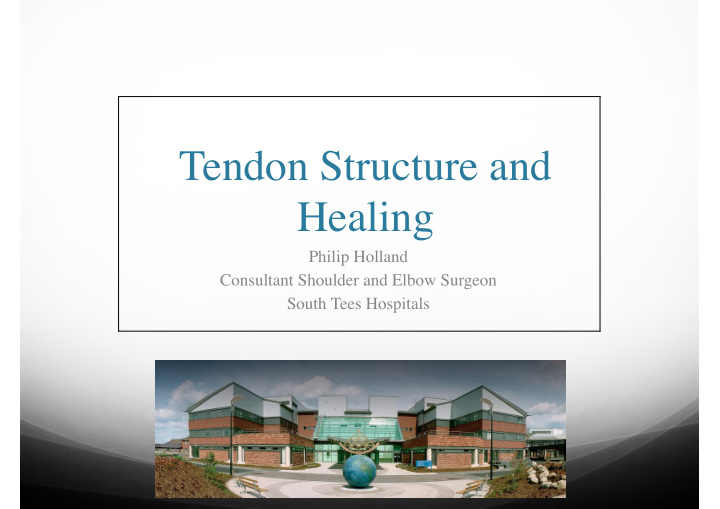



Tendon Structure and Healing Philip Holland Consultant Shoulder and Elbow Surgeon South Tees Hospitals
Tendons • Attach muscle to bone • Transmits tensile force • Enable muscle to be optimally positioned • Store energy
Macroscopic Structure • Two types of tendon: • Lubricated tendons in synovial sheaths • Thick paratenon surrounded tendons
Blood supply • Blood supply from muscle insertion • Paratenon covered tendons • Paratenon blood supply • Sheathed tendons - avascular • Venicuar blood supply • Nutrition by diffusion
Tendon Healing • Synovial fluid surrounded tendon • Direct intrinsic healing • Paratenon surrounded tendons • Phase 1 inflammatory (hrs) haematoma, polymorphs and macrophages • Phase 2 proliferative (weeks) neovascularisation and fibroblasts (III collagen)
Microscopic Structure • Cells 20% volume • Mesenchymal stem cell • Tenocytes • Fibroblasts • Extracellular matrix 80% volume • Elastin • Collagen • Ground substance
Collagen • Type 1 collagen 90% • Type 3 collagen <10% • Protein structure
Collagen • Primary structure - three amino acid chains • Secondary structure - left handed helix • Tertiary structure - right handed triple helix • Quarternary structure - quarter staggered array
Ground Substance • Hydrophilic spacers • Proteoglycans • Glycoproteins
Ground Substance • Proteoglycan
Tendon Properties • Stress • Strain • Viscoelastic
Tendon Properties • Stress = force / area • Strain = change in length / original length • Viscoelastic = time dependent properties
Stress Strain Curve
Tendon Properties Viscoelasticity • Creep • Stress Relaxation • Hysteresis
Tendon Properties Viscoelasticity • Creep
Tendon Properties Viscoelasticity • Stress Relaxation Strain Stress
Tendon Properties Viscoelasticity • Hysteresis
Conclusion • Tendons • 80% extracellular matrix • 20% cells • Blood supply • Paratenon • Veniculi and diffusion
Conclusion • Draw a proteoglycan • Draw stress strain curve
Questions
Recommend
More recommend